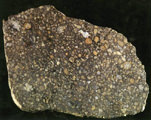Earth, with its blue hue visible from space, is known for its abundant water – predominately locked in oceans – that may have come from an extraterrestrial source. New research indicates that the source of Earth’s water isn’t from ice-rich comets, but instead from water-bearing asteroids.
Looking at the ratio of hydrogen to deuterium, a heavy isotope of hydrogen, in frozen water, scientists can get a pretty good idea of the distance the water formed in the solar system. Comets and asteroids farther from the Sun have a higher deuterium content than ice formed closer to the Sun. Scientists, led by the Carnegie Institution for Science’s Conel Alexander, compared water from comets and from carbonaceous chondrites. What they found challenges current models in how the solar system formed.
Primeval Earth was a hot and dry place. Any water that may have formed with Earth was boiled away from the scorching crust. Ultraviolet light from the newly formed Sun stripped hydrogen atoms from the water molecules leaving no rain to fall back on the surface. Scientists believe that both comets and carbonaceous asteroids formed beyond the orbit of Jupiter, perhaps at the very fringes of the solar system, then moved inward bringing both water and organic material to Earth. If this were true, Alexander and his colleagues suggest that ice found in comets and the remnants of ice preserved in carbonaceous chondrites in the form of clays would have similar isotopic composition.
 After studying 85 carbonaceous chondrites, supplied by Johnson Space Center and the Meteorite Working Group, they show in a paper released today by Science Express that they likely did not form in the same regions of the solar system as comets because they have much lower deuterium content. They formed closer to the Sun, perhaps in the asteroid belt between Mars and Jupiter. And its that material that rained on early Earth to create the wet planet we know today.
After studying 85 carbonaceous chondrites, supplied by Johnson Space Center and the Meteorite Working Group, they show in a paper released today by Science Express that they likely did not form in the same regions of the solar system as comets because they have much lower deuterium content. They formed closer to the Sun, perhaps in the asteroid belt between Mars and Jupiter. And its that material that rained on early Earth to create the wet planet we know today.
“Our results provide important new constraints for the origin of volatiles in the inner solar system, including the Earth,” Alexander said. “And they have important implications for the current models of the formation and orbital evolution of the planets and smaller objects in our solar system.”
Image caption: Artist impression of an asteroid impact on early Earth (credit: NASA)
Image caption 2: This is a cross-section of a chondritic meteorite.



